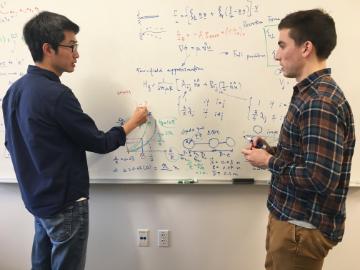Creating Biomedical Robots to Help Doctors Discover and Diagnose

On Shun Pak with graduate student Grant Mishler '18
For decades, doctors and clinicians have snaked, pushed, and prodded diagnostic tools outfitted with cameras through their patients’ bodies to get a look at what was happening inside, but now a team of engineers has accepted a challenge from the National Science Foundation (NSF) and is developing a new class of soft, pliant 3-D printed robots for diagnostic and therapeutic applications. Self-propelling, these tethered and untethered mini marvels (with diameters of ~0.1-10 mm) will actively wiggle and assist in their own propulsion and maneuvering along the body’s natural pathways, making GI-tract exploration safer, and providing access to previously off-limits areas of the brain, the body’s most fragile and complex organ.
Faculty from the lead institution, University of Utah (Jake Abbott, Kam Leang, Yong Lin Kong), teamed up with Rajesh Rajamani from University of Minnesota and Santa Clara mechanical engineering assistant professor On Shun Pak to develop this new class of MESo-C3 (magneto-electroactive, soft, continuum, compliant, and configurable) robots for medical applications across scales. The team received a $2 million NSF grant for this collaborative project. Pak will receive $338,440 to assist with theoretical modeling to understand the propulsion dynamics of MESo-C3 robots. The funding will support both undergraduate and graduate students to conduct the proposed research
Pak explained, “Each of us on the team contributes his own expertise to the goal of understanding the kinematics, dynamics, sensing, and control of 3D-printed MESo-C3 robots. Throughout the project, I will employ a variety of modeling tools to elucidate the propulsion dynamics and support the design and optimization of these soft robots.”
The team’s work will extend the capability of the doctor to diagnose and to provide more access to locations in the human body that are currently hard or impossible to reach. Soft robots are less damaging to the body, and the ability to self-propel rather than being pushed or screwed or pulled through the biological environment is a promising advancement that could fundamentally change diagnostics. “It’s very exciting to work on this NSF-funded collaborative project in a team with diverse expertise,” Pak said. “From theory to experiments to prototyped robots that have significant medical applications—I’m grateful to be part of the process and look forward to working with these colleagues over the next four years.”

Pak’s theoretical fluid mechanics group at SCU (L-R): Dr. Herve Nganguia (postdoc researcher; now Asst. Prof. at Indiana U of PA), Grant Mishler (BS ’18, now MS student at SCU), Dayna Obenauf (BS ’17; now PhD student at Purdue), Sagar Bhatia (MS ’17; now Intern at SunMan Engineering), Kyle Pietrzyk (BS ’16, MS’ 18; now PhD student at Stanford)